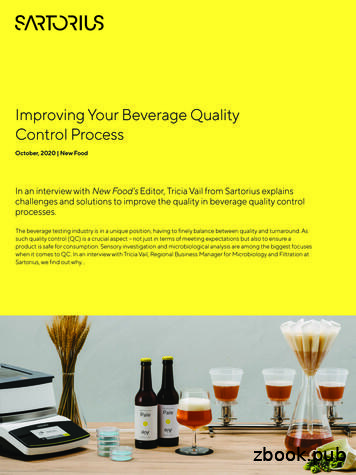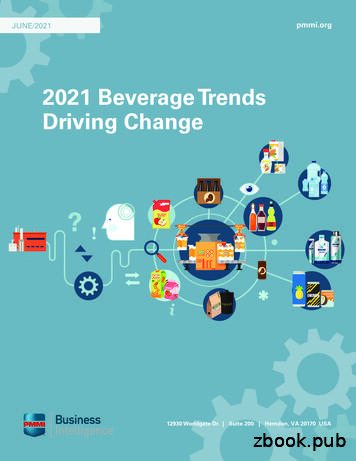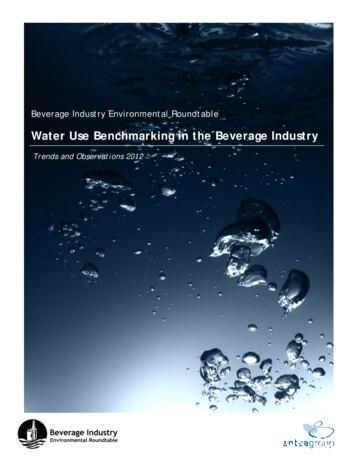Improving Your Beverage Quality Control Process - Sartorius
Improving Your Beverage QualityControl ProcessOctober, 2020 New FoodIn an interview with New Food’s Editor, Tricia Vail from Sartorius explainschallenges and solutions to improve the quality in beverage quality controlprocesses.The beverage testing industry is in a unique position, having to finely balance between quality and turnaround. Assuch quality control (QC) is a crucial aspect – not just in terms of meeting expectations but also to ensure aproduct is safe for consumption. Sensory investigation and microbiological analysis are among the biggest focuseswhen it comes to QC. In an interview with Tricia Vail, Regional Business Manager for Microbiology and Filtration atSartorius, we find out why
Improving Your Beverage Quality Control ProcessQ: What determines a high-quality beverage?A high-quality beverage always comes down to a personaltouch and that will differ for each type of drink. It’s aboutthe aroma, the colour, the clarity, the mouthfeel, andsometimes even the sound of the beverage when it is firstopened. If any one of these characteristics are differentthan what the user is expecting, there is a high risk that theygo on to the next beverage.Q: What are the biggest challenges for a beverageproducer?There are so many aspects and never enough time to havelook at all of them. From high quality raw materials to fullytrained personnel and qualified testing methods, each ofthese must work together and when one starts to slip that iswhen things go wrong.As a beverage producer, it all starts with passionate, fullytrained and qualified experts. Without these people on theproduction floor, in the QC labs, in shipping or in yourtasting rooms, you will lose the passion and love for thecraft. Keeping that ‘thirst’ alive is key to making yourbeverage the best it can be.The raw materials needed are a given; what is oftenoverlooked is the assurance that these materials beingused are within the specifications that were requested. Forexample, when buying hops for brewing beer havingexcessive moisture can lead to a spoilage contamination,inefficient yeast fermentation, or even excessive hop creep.By analysing a sample of the hops for moisture content withan instrument such as the Sartorius Moisture AnalyzerMA160, wasted beer can be avoided and the lot of hopsrejected. Besides, who wants to pay for excess water whenthat is not what you want?2This leads to the necessity of having qualified methods toensure that the raw materials, production processes andfinished goods all meet your specifications to ensure thecustomers’ desires. Without having these qualifiedmethods and products in your QC testing laboratories, theassurance for a high-quality beverage on the market is lowand the brand will suffer for it.Q: How can taste be influenced and enhanced throughquality control?Taste and mouthfeel are an essential aspect of QC; withoutproper testing how can you know for certain that yourbeverage meets your specifications and your customers’expectations? There are two major fields to QC – analyticaland microbiology – along with a smaller lesser discussedarea – physical.QC analytical testing is typically the first and easiestlaboratory to set up. The methods are clear, precise anddeveloped. From a laboratory water system like theSartorius Arium Lab Water System to an HPLC system, setup of the analytical or chemistry testing laboratory can bequick and easy. From there, to perform testing such asalcohol by volume (ABV) or syrup concentration or mineralcomposition can be done using analytical instrumentationand sample preparation devices such as Minisart SyringeFilters.QC microbiology testing, although key, is often overlookedand mysterious. If anything is going to go wrong with aproduction run, more often than not, it will be thislaboratory that will find it. The QC microbiology laboratoryis where the spoilage microorganisms are detected, wherethe yeast titres are determined, where water testing isconducted. The best part about QC microbiology andbeverages is that most beverages are filterable; by using a
“From high quality raw materials tofully trained personnel and qualifiedtesting methods, each of these mustwork together and when one starts toslip that is when things go wrong.”Tricia Vail, Regional Business ManagerSartoriusBiosart 100 Monitor or Biosart 250 funnel and a NutrientPad Set any spoilage microorganism can be detected.Once you know you have a spoilage microorganism andwhat type it is, you will most likely know where it has comefrom and how to get rid of it. Unless it is a beer stone, inwhich case, just cut that out of your system, install newpiping and set up a robust prevention program.One important but often neglected area is QC physicaltesting. Using large pore size membrane filters, laboratorieswill test the product to ensure there is not any barrel/woodfragments in the product which can be detrimental. Theselarge pore size membrane filters can also help to removefloc haze which can be seen after having the beverages siton the shelf after some time. Floc haze and wood fragmentsdo not necessarily affect taste, however, they are unsightlywhich can be off putting. After all we do ‘taste’ with oureyes.Q: If implementation of a QC programme is not in placewhat is the potential impact on the company and thebrand?Often small start-up beverage companies do not have aQC programme in place nor are they required to do so.Each country has different criteria as to when a QCprogramme is mandatory so check with your localauthorities to determine your ‘when’.Regardless of when, the sooner you start to implement aQC programme into your production process, the easier itwill be for the whole organisation to adopt to it. It will alsosimplify the process of making the necessary changes asyour facility evolves.Having flexibility within your site to find and mitigate thesequality challenges as they arise will help you to prepare forthe regulatory authorities – they will show up for aninspection.Q: What solutions does Sartorius offer to improveproduct quality and safety? How do they work?Sartorius has two divisions which work together to offer arange of products for the beverage industry; these stretchfrom the beginning of the process to the final product andeverything in between. These products comply with FoodContact Compliance (FCC) and Hazard Analysis CriticalControl Point (HACCP) to ensure that all beverages havecontaminates removed and have verification that thosecontaminates are removed, as well as meeting otherregulatory requirements.Whether it is using the Aquasart PS for production waterfiltration or the Microsart Microbiology manifold toconduct microbiology testing, these products will ensureyour beverage is among the finest on the market.Q: What is spoilage detection and how can it affectbeverages?Spoilage detection refers to spoilage microorganismdetection which is very common within the beverageindustry. As beverages are not sterile and there are strainsof microorganisms which cause beverages to spoil andtherefore have an off color, off taste, off odor, off mouthfeel,etc. In some beverages, they can be harmful to be ingestedand will require a product recall. In other beverages, it ismore detrimental to the brand than anything else.For example, there is a fruit juice that was recalled manyyears ago due to a microorganism contamination. Thecompany has since rectified this production challengehowever, I still think about that particular product recallevery time I see that fruit juice at the supermarket.3
“Without having qualified methodsand products in your QC testinglaboratories, the assurance for a highquality beverage on the market is lowand the brand will suffer for it.”Tricia Vail, Regional Business ManagerSartoriusQ: How can water contamination occur and what impactwill it have?When I get calls from beverage companies asking for helpdue to a contamination, my first question is always ”How isyour water?” The answer is usually fine. With a bit morecoercing, the answer is almost always, we don’t really testour water very often. Maybe once or twice a month(sometimes once a quarter!). “It’s just water. It’s fine.”Water is essential to nearly all beverages and yet this istaken for granted so often. Clean water vs. Dirty water willmake or break most beverages!The composition of water is different in a large city ascompared to well water in a rural area, there are evenseasonal differences. The chemical composition is different,the microorganisms are different, the physical materials inthe water are different. When you don’t treat the water, allof this “stuff” makes it’s way into your beverage and this willalter every aspect of the beverage as well as clog up thepiping within the production line causing beer stones orbiofilms both of which are nearly impossible to removeonce they have made into your system.Water is so essential and I cannot stress enough theimportance to treat and test your water to make sure thatthis stays that the highest level of quality in your facility.Here are two examples of how water has made a differenceto two companies:A large beer company has two production sites. One, theprimary site, is located in a major metropolitan city and theother production site is located in a rural site. The city sitegets the water from the city water system whereas the ruralsite uses a well. Because the “brand” is known by the cityproduction site, the rural production site “treats” its water to4match the chemical & physical characteristics of the cityproduction site each day. This way, regardless of where thebeer is made, the consumers will not know which site madethe beer.Another example is when I received a call from a spiritmanufacturer who was experiencing floc haze and couldnot understand why this was happening. They had done allthe QC testing on the production line, raw materials, oakbarrels, etc yet when the product was in the bottles, theyhad severe floc haze. After an investigation, it turns out thattheir large proofing water tank what always “kept full” &“warm” too prepare for bottling but they never treated thewater. Hence, a biofilm developed in the water tank sowhen they mixed the spirt with the water to get the rightalcohol by volume, they were adding bacteria to the alcohol,the alcohol did it’s job by killing off the bacteria and the flochaze was all the killed bacteria floating. This spiritmanufacturer now flushes and cleans the water tankmonthly and tests the water for microorganisms daily.Q: What is air monitoring and why is it important?Air monitoring at the filing stations may seem a bit strangeespecially since most beverages are not filled in a cleanroom. In fact, most are filled inside of a warehouse likestructure. With all that said, there is air being blown into thebottles, cans or kegs at time of filling and then these arecapped. By testing this air, you can have additional data toshow if there is any potential spoilage microorganismswhich could potentially be in the beverage. Using the MD8Airport Air System with the Gelatine Membrane Filters, youcan use one membrane filter for your whole filling run andthen place the Gelatine Membrane Filter on a microbiologymedia plate for microbial detection.
“QC microbiology testing, althoughkey, is often overlooked andmysterious. If anything is going to gowrong with a production run, moreoften than not, it will be this laboratorythat will find it”Tricia Vail, Regional Business ManagerSartoriusQ: Define check weighing and how it can affect brandtrust and cost?Check weighing is one of the last QC tests conducted onthe pre-packaged product like cans, bottles and kegsbefore final boxing and shipping. It is the measurement ofthe Net/Actual Content of the product, checked andcompared with defined upper and lower tolerances in orderto accept or discard the package, as per your specificationsin the label/marking. These specifications and tolerancesare set by each country trade regulations and harmonizedworldwide by the World Trade Organization for internationaltrade purposes. The check weighing may be carried out byrandom sampling of pre-packages in a single batch or byweighing each bottle in line.Want to know more about the solutions from Sartorius,please visit: www.sartorius.com/beveragesTricia Vail has had two decades of experience in qualitycontrol microbiology and represents the US on several ISO,ASTM & AOAC committees in water, water reuse, air,cannabis and food products international regulatorycommittees. She currently works for Sartorius Corporationas Regional Business Manager for Microbiology andFiltration.ReferencesThis interview was published by New Food in October 20205
GermanySartorius Lab Instruments GmbH & Co. KGOtto-Brenner-Strasse 2037079 GoettingenPhone 49 551 308 0F or further contacts, visitwww.sartorius.com/ beveragesSpecifications subject to change without notice.Copyright Sartorius Lab Instruments GmbH & Co. KG.Status: 09 2020USASartorius Corporation565 Johnson AvenueBohemia, NY 11716Phone 1 631 254 4249Toll-free 1 800 635 2906
industry. As beverages are not sterile and there are strains of microorganisms which cause beverages to spoil and therefore have an off color, off taste, off odor, off mouthfeel, etc. In some beverages, they can be harmful to be ingested and will require a product recall. In other beverages, it is more detrimental to the brand than anything else.
Beverage Marketing Corporation utilizes an integrated model for providing information, analysis and advice to beverage industry clients -3- Copyright 2016 Beverage Marketing Corp. Introducing The Beverage Packaging Data MODULE The latest addition to Beverage Marketing Corporation's DrinkTell Database with Market Forecasts!
Beverage Marketing Corporation utilizes an integrated model for providing information, analysis and advice to beverage industry clients -3- Copyright 2016 Beverage Marketing Corp. The Shifting Beverage Landscape Agenda I. Market Overview II. Key Trends III. Category Updates IV. Projections -4- Copyright 2016 Beverage Marketing Corp.
2 2021 BEVERAGE TRENDS DRIVING CHANGE CONTENTS 3 Dominant Trends in the Beverage Industry 4 Opportunities Abound for Beverage Suppliers 6 Consumers Looking for Sustainability 11 Beverage Functionality and Convenience 13 Health Consciousness is a Driver of Change 15 SKU Expansion for Most 17 COVID-19: The New Variable 22 Beverage Manufacturers' Machine Needs
Your Food and Beverage Certificate (FB) is a subordinate permit to your primary permit and will be printed on the face of the primary permit. The primary business at your establishment must be food service as long as you are maintaining the Food and Beverage Certificate. Alcoholic beverage sales cannot exceed 60% of gross receipts of the licensed
Water Use Benchmarking in the Beverage Industry Trends and Observations . Clean, high-quality water is the essential ingredient for all products of the beverage industry. For years, beverage companies have focused on water use avoidance and conservation to demonstrate one aspect of environmental stewardship. Since 2007, the Beverage Industry
The Division of Alcoholic Beverage Control Investigations Bureau is within the Division of Alcoholic Beverage Control and is responsible for investigating criminal and administrative violations of the Alcoholic Beverage Control Act (N.J.S.A. 33:1-1 et seq.) and the attendant regulations (N.J.A.C. 13:2-1.1 et seq.).
Answer: Both the physical and mailing address of Alcohol Beverage Control is: 700 South Stratford Drive, Ste 115, Meridian, ID 83642. Question: What are the lobby hours of Alcohol Beverage Control? Answer: The lobby hours of Alcohol Beverage Control are Monday through Friday, 8 am to 4:30 pm. The office will be
percent is generated through the sales of food and beverage. Even though room sales is supposedly more perishable product of a hotel as compared to food and beverage sales, but the importance of food and beverage sales cannot be taken away as the majority of the publicity and reputation of the organization largely depends on food and beverage .























